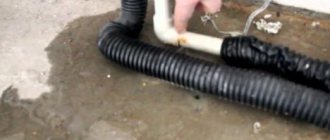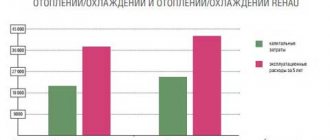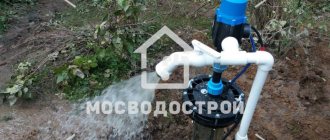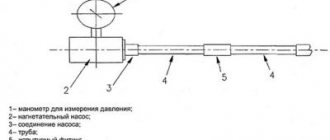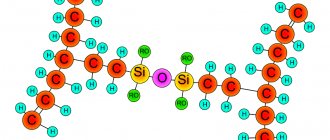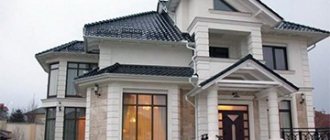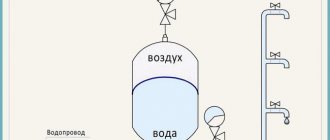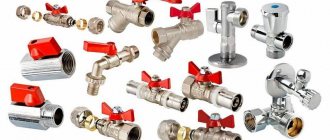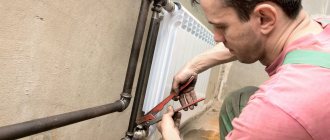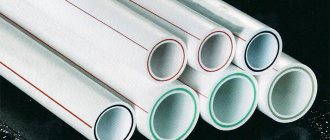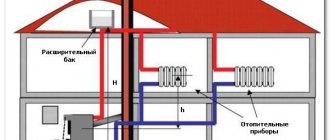Installation of autonomous home heating systems is made from pipes of various types. The practice of recent years shows that the best ones are made from cross-linked polyethylene, which are produced by the German concern Rehau. They have excellent characteristics and are suitable for heating devices with radiators and underfloor heating systems. In order to choose the right Rehau pipes for home heating, you need to become familiar with their main types, characteristics and features of use in specific wiring diagrams.
Rehau systems: varieties and brief characteristics
The Rehau brand produces pipes with various characteristics, so you can choose the necessary material to suit your individual needs. The Rehau product catalog includes the following products:
- Rehau Rautitan stabil;
- Rehau Rautitan flex;
- Rehau Rautitan pink;
- Rehau raititan his.
The stabil product line is universal pipes that are equally successfully used for both cold and hot water supply and heating. To make such a pipe, polyethylene with an inner aluminum layer is used. When performing installation, you can additionally use corrugated pipes or fireproof cuffs.
Rehau Rautitan stabil pipe
Rehau Rautitan flex pipes are distinguished by their flexibility and mobility. The pipeline is made of polyethylene and is used for water supply and heating. This type of material is resistant to corrosion, the formation of deposits and scale, is wear-resistant and impact-resistant. Installation of flex pipe requires the additional use of fittings and components of the appropriate size.
Rehau Rautitan flex pipe
Rehau Rautitan pink pipes are used exclusively for heating systems. The material for their manufacture is molecularly cross-linked polyethylene, and their distinctive feature is their characteristic pink color. Installation requires appropriately sized fittings and components.
Pipe Rehau Rautitan pink
Rehau Rautitan his are systems for cold and hot water disposal. Installation is carried out according to a scheme common to all Rehau systems and requires the additional use of branded components.
Trumpet Rehau Rautitan his
For heating, you can use Rehau Rautitan stabil, flex or pink systems, depending on the individual needs of each customer.
The pipeline diameter ranges from 17 to 63 mm. The innovative products of the German company can reduce energy consumption by up to 60% and compare favorably with their analogues.
Classification
What does Rehau offer today? The scope of application of the pipes it produces is quite wide. In construction, these are heating systems, plumbing, hot water supply and sewerage.
Sewerage
They are made from polypropylene. Brand – RAU-PP1221. Among the technical characteristics, it is necessary to note the long service life; the products can withstand heavy loads and temperatures. Let's add ease of installation here.
The elements are connected using fittings and shaped products. The company offers sewer pipes that can be used for both internal and external networks.
Cold and hot water supply
For these systems, the company produces products made from cross-linked polyethylene.
This variety is gradually replacing metal-plastic analogues due to its high technical and operational characteristics and ease of installation.
The most important thing is that the manufacturer has achieved a high level of stitching quality. This is what makes it possible to install rehau pipes in systems with fairly harsh operating conditions.
Heating
This life support system uses two types:
- Metal-plastic.
- Made from cross-linked polyethylene.
Gradually, pipes from the second group are replacing the first type. This is due to new requirements for heating systems, where the water temperature sometimes reaches +100 °C. Metal-plastic products can only withstand +95 °C.
The main differences between Rehau products and polypropylene pipes
The Rehau pipeline is made of high-quality polyethylene, which is significantly superior to polypropylene products. The main advantages of the Rehau heating pipeline:
- Corrosion resistance;
- Operating temperature up to 95 °C, while polypropylene pipes do not have such a wide temperature range without loss of quality;
- Low thermal conductivity;
- They have a shape memory effect, which ensures absolute tightness of the connection;
- Resistant to scratches and other mechanical damage;
- They have good sound insulation;
- UV resistance;
- Service life up to 50 years.
In comparison, polypropylene products are exposed to ultraviolet radiation and have significant thermal expansion. Rehau represents a new level of development of heating equipment, which has an optimal balance of reliability and functionality.
Advantages of Rehau pipes
Rehau heating pipes (REHAU) in our country are second in popularity only to polypropylene products, which are cheaper. However, to connect polypropylene pipes it is necessary to use a welding device, which complicates the process of installing heating and water supply systems.
The technology of Rehau polyethylene cross-linked pipes is simplified as much as possible. To connect them, a system of sliding sleeves has been developed, which creates strong and reliable pipelines.
The essence of this method is that the pipe is clamped inside with a coupling fitting, and a movable sleeve is pushed onto it from the outside, which creates a strong connection. Thanks to the simplicity and ease of installation, almost anyone can make a reliable pipeline in a short time.
As a result, we can conclude that Rehau pipes, despite the cost, have significant advantages:
- high quality and reliability of heating systems;
- convenience and ease of installation;
- the use of numerous fittings and additional elements allows you to create the most complex connections in a short time.
In fact, the entire Rehau system is a construction set for assembling the necessary life support systems in a private house or apartment with your own hands.
Technical characteristics and properties of communications
The company's most popular product is the Rehau heating pipe RAUTITAN pink
has the following features:
- maximum level of operating temperature of use - +95 degrees;
- the maximum temperature at which pipes are used for a short time is +110 degrees;
- the permissible pressure level in the pipes is 10 atmospheres;
- products are produced with diameters from 16 to 63 millimeters;
- The warranty period for using the pipe is at least 50 years.
A distinctive external feature of this pipe for the convenience of consumers is the pink or purple color of the product.
Another type of Rehau heating pipes is a product called Rautitan stabil. The main difference from the previous pipe is that the outer diameter ranges from 16 to 40 millimeters, and the maximum permissible temperature level is +100 degrees Celsius. This type of pipe uses an inner layer of PEX, which gives the product special strength, which is maintained even if the aluminum shell is damaged.
Rautitan stabil pipes are used, as a rule, in the heating system to organize the supply of hot water with temperatures up to +95 degrees and at operating pressures up to 10 bar.
Rehau underfloor heating
The Rehau company offers its customers a surface floor heating system. The main element of the underfloor heating system is the Rauterm-S pipe, although universal heating pipes can also be used.
Rehau underfloor heating
The underfloor heating system produces air heating due to radiant heat exchange. Due to the large area of use, the device of a heated floor evenly distributes air throughout the entire height of the room and creates comfortable conditions for human life.
If desired, the underfloor heating system can be equipped with electronic temperature controllers. This will automate the device and significantly reduce energy consumption.
Alternative energy sources such as solar panels or heat pumps can be used as a power source for the underfloor heating system. Rehau underfloor heating can be installed in both residential and industrial premises, offices, and municipal institutions. It can increase the room temperature by several degrees in a fairly short period of time, and if the temperature is too high, the system can be used for cooling.
RAUTITAN system
RAUTITAN is the name of the entire Rehau piping system made of cross-linked polyethylene and sleeve joints.
Main advantages of the RAUTITAN system:
- The connection is on a sliding sleeve (axial pressing), which is convenient for installation, durable, and can be immediately loaded with pressure and temperature.
- Due to the absence of O-rings, the likelihood of installer error is minimized.
- There are no narrowings at the pipe-fitting transition (in the case of axial pressing).
- Unified fittings for all pipes.
- Pipe diameters from 16 to 63 mm.
- It is allowed to install the pipe directly to heating devices.
- No corrosion.
All pipes of the RAUTITAN system are cross-linked using the chemical peroxide method, have the PEX-a index and have the highest cross-linking percentage:
- among all PEX pipes they have the greatest flexibility;
- creases can be straightened with a hair dryer and the performance characteristics will be fully preserved;
- good “molecular memory”.
Pipe REHAU RAUTHERM S
RAUTHERM S is a special type of polyethylene products that is used for heated floors in the construction of residential and administrative buildings.
Pipe Rehau RAUTHERM S
Main advantages in comparison with competitors:
- Resistant to high temperatures, can be used at temperatures up to 90 °C;
- Corrosion resistance;
- No salt deposits;
- Chemical resistance;
- Resistance to mechanical wear;
- Resistance to abrasive wear.
The pipeline is available in diameters from 17 to 25 mm and has a service life of up to 50 years. The pipe for heated floors meets all European quality standards and sanitary standards.
Main types of heating pipes
Among all types of company products there are products of different types and purposes. RAUTITAN pink, RAUTITAN flex, RAUBASIC (obsolete, with press connections), RAUTHERM S are intended for heating. The advantages of the brand’s products are that a full range of products is introduced to the market, allowing you to assemble a system of any configuration from standard components produced by one company.
- One of the main types is the Rautitan flex series, universal products for water supply and heating systems, both external and hidden. Very flexible. Retain the shape given during installation without disturbing the structure.
- Rehau Rautitan stabil is a brand with a stabilizing aluminum layer. Designed for an operating temperature range with an upper limit of +90 0C with the possibility of short-term exceeding. They behave more stable under temperature changes than flex.
- Rautitan pink - pink color, designed specifically for heated floors. These are one of the few types of Rehau products that cannot be used in water supplies - they contain ethylene vinyl alcohol, an undesirable component in drinking water.
- RAUTHERM S - for heated floors. Due to its red color and high flexibility, it is difficult to use in heating systems in rooms, but very convenient for installation in walls.
Area of use: heating systems in the residential and non-residential sector, including large industrial and public buildings, airports, train stations, shopping centers.
Installation of the Rehau heating system
Installation of Rehau plastic and metal-plastic heating systems is carried out according to the same principles as in cases where polypropylene products are used.
Rautool M1
The only minor differences are in the following points:
- Installation is carried out using a special Rautool tool, which makes connections in a diameter range from 14 to 110 mm. The drive for the tool can be manual, battery or electric;
- Heating installation requires the use of special polymer fittings of various diameters;
- The company’s own development is the installation of elements with a movable sleeve, which allows the pipeline to be installed without revisions.
In general, it should be noted that the installation of ready-made systems from the German company Rehau is much easier than installing polypropylene pipes. The manufacturer has thought through everything to the smallest detail so that the heating installation is carried out as quickly and efficiently as possible.
Polypropylene pipes
Polypropylene belongs to thermoplastics - polymer materials whose characteristics change depending on the ambient temperature. At 140°C the basic type of this polymer (labeled PP - “PP”) softens, at 170 it melts. Based on these figures, the maximum operating temperature for polypropylene products is considered to be 120°C, but in the absence of pressure.
For the manufacture of pipes, it is not basic polypropylene that is used, but several of its varieties, differing in the values of individual characteristics. In addition to individual pros and cons, these varieties have an impressive number of advantages inherent in all polymer pipes.
The most significant advantages of all polypropylene pipes:
- Environmentally friendly. Polypropylene does not release anything into the environment; water from contact with it does not acquire foreign odors or tastes, and does not change color.
- Seamless design. The absence of seams means the uniformity of the wall structure, increasing the tightness of straight sections.
- Ability to withstand fairly high pressure.
- Absolute moisture resistance of polypropylene.
- Low thermal conductivity. For hot water supply and heating systems, this means low heat loss through the walls of the pipes, and for cold water supply pipelines - insignificant formation of condensate on open-mounted lines only with very cold water. Therefore, there is no need to insulate the wiring.
- Frost resistance. Applies to all polypropylene pipes, except PP-N - these are intended only for internal installation, since at low temperatures the material of manufacture becomes brittle. The frost resistance of other PP pipes is determined by their type - from -20°C to the lowest temperatures in the coldest regions.
- Low hydraulic resistance. The inner surface of PP pipes is smooth, and over time it becomes covered with a specific coating that fills all micropores. For users, this means no noise when water moves.
- Easy to install and widely affordable price. To install lines from polypropylene pipes, you do not need expensive equipment - the fragments are connected using a special, inexpensive “soldering iron”, the skills of which can be acquired quickly. PP pipes and connecting fittings are several times cheaper than their metal counterparts.
- Durability. With the right choice, polypropylene pipes last up to 50 years - the same as the enclosing structures into which they are embedded.
Based on this list of advantages, professionals believe: if pressure and temperature allow, there is no reason to use metal pipes instead of polypropylene.
Among the disadvantages of polypropylene pipes, it should be noted:
- High coefficient of thermal expansion. In practice, this means that the elongation of, for example, a 3-meter fragment after heating can be up to 2 centimeters.
Methods for taking this factor into account during installation are defined by SNiP 2.04.05-91 - this is the installation of compensation niches at turns, the installation of supports every 0.5 m on straight sections.
- Elasticity. The permissible radius of curvature of the pipe when bending is large, and in most cases it will not be possible to “go around” a right angle without fittings - for this you need to use special home-grown methods that are not recommended by manufacturers. If you follow the rules, then each element welded into the line is an undesirable increase in the number of joints. When going around a bend of slight curvature, the line at the bend will remain in a tense state.
- Thick pipe walls. This increases the outer diameter, therefore, grooves for hidden installation need to be made deeper, which weakens the base. And the thermal insulation of an open cold water supply will make the polypropylene wiring even thicker.
To the listed “minuses” we can also add the low resistance of some types of PP pipes to ultraviolet radiation, but this drawback is relevant only for external pipelines, because even transparent window glass does not transmit UV rays.
It should be noted that the other disadvantages are not critical - they are either neutralized by appropriate methods, or do not appear when the installation is carried out correctly. Examples of this are the installation of supports in half-meter increments, or high-quality soldering of joints.
Conclusion: polypropylene pipes are a high-quality and at the same time cheap material that allows you to install reliable heating systems, hot and cold water supply. Necessary conditions for the reliability and durability of the installed circuits are the correct choice of the type of PP pipe, its compliance with GOST and proper installation.
Rautitan fittings for heating installation
Threadless fittings are made from a new generation polymer material – polyphenylsulfone. This material demonstrates the highest strength indicators, several times superior to metal components.
Rehau fittings
Fittings include the following main groups:
- Mounting sleeves;
- Couplings;
- Adapters with external and internal threads;
- Connecting fittings;
- Squares;
- Tees;
- Pipes for connecting radiators;
- Plugs;
- Guides;
- Fixing gutters;
- Distributing comb;
- Brackets;
- Fire cuffs.
Installation features
Rehau pipes are produced using the cold pressing technique with a sleeve.
The main nuance of installing pipes from a German manufacturer is that there is no need to use welding or additional fasteners. The system is constructed using a cold pressing technique with a sleeve. This installation method is as safe as possible for humans. In addition, the press ensures the reliability and tightness of the system. In general, the process of assembling a water supply system from Rehau tubes is designed in such a way that if the installation is incorrect, the master will immediately see all the flaws. If the system is assembled correctly, its appearance will be perfect.
The construction of the Reahau water supply system takes place in several stages:
- Take a piece of pipe and put a sleeve on it. Its chamfer must first be set in the direction of the joint to be mounted.
- In turn, the lumen of the second tube is expanded using a special expander.
- The prepared cut with an expanded hole is put on the fitting of the previous part of the system and the sleeve is crimped using a sleeve.
Even a non-professional can handle the installation of the Rehau water supply system.
Pros and cons of using Rehau pipes
Rehau cross-linked polyethylene systems have gained the greatest popularity, overtaking the Polish manufacturer KAN and the Israeli Golan .
Moreover, the products are more expensive than steel or polypropylene pipelines. But the high price is fully compensated by the advantages, which ensures high demand.
Advantages of Rehau pipelines
- Simplicity and speed of installation. The pipe can be easily cut with scissors. After obtaining the desired length, simply insert the fitting and tighten the connection with a tension sleeve. No rubber O-rings are required. Over time, such a connection will not lose its tightness, since there are no degrading rubber parts. Therefore, after assembling the pipeline, it can be installed in the screed without fear of possible leaks. This is important because with hidden installation, an accident will lead to serious consequences.
- The geometry of the pipes can be changed without loss of quality. Polypropylene or metal-plastic cannot be bent so safely. Therefore, Rehau products are well suited for complex structures.
- High molecular weight polyethylene has outstanding sound insulation abilities. This significantly increases the comfort of use.
- Durability. The manufacturer guarantees trouble-free operation of such pipelines for 50 years. Compared to products made from other materials, this has an outstanding service life.
- Cross-linked polyethylene is not subject to corrosion and scale does not form inside. Therefore, over time, the quality of operation does not deteriorate.
- The products are manufactured in Germany, which is an additional guarantee of quality.
Disadvantages of cross-linked polyethylene pipes from Rehau
- High cost of the system. An excess of tees and bends leads to higher prices. This is due to the high cost of fittings. These parts for polypropylene will cost several times less.
- Poor elasticity. This leads to difficulties in line alignment. This can only be done using additional fasteners.
- High cost of installation tools. When installing pipes up to diameter 32, you can get by with a kit that costs about $400. But if the pipe diameter starts from 40 mm, then the prices for tools increase sharply. In this case, you will have to pay at least 2 thousand dollars for the purchase. But you can still save money by renting equipment from a materials supplier.
Rehau cross-linked polyethylene pipe range
- Rautitan his. Used for hot and cold water supply, can withstand heating up to 70 degrees.
- Rautherm S. Designed for heating systems, resistant to pressure and high temperatures. It is highly flexible and can therefore be installed at low temperatures.
- Rautitan flex. A universal option that can be used for heating and water supply.
- Rautitan stabil. It has the same abilities as the previous type of pipe. At the same time, it can withstand short-term temperature increases better. The advantage is the presence of an aluminum layer that protects the pipes from linear expansion. This also increases the rigidity of the product, which simplifies the implementation of linear structures.
- Rautitan basic. It is rarely used in modern systems, as it is equipped with radial compression fittings. The technology is considered outdated.
- Rautitan pink. Slightly inferior to flex pipes, but the cost is lower.
Rehau's wide variety of cross-linked polyethylene pipes makes it easy to select products for a specific project. Thanks to the high tightness of the connections, high complexity of designs is possible.
Source
